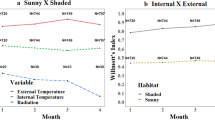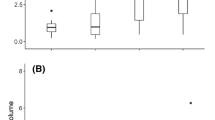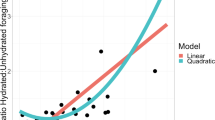Summary
The responses of the four fire ant species found in Texas (Solenopsis aurea Wheeler,Solenopsis geminata Fabricius,Solenopsis invicta Buren, andSolenopsis xyloni McCook) to varied relative humidities were examined. Humidity preferences of worker ants were determined with a linear gradient chamber. Workers alone did not exhibit any hydrokinetic responses, whereas brood tending workers of all species tested showed a marked preference (negative hydrokinesis) for saturated atmospheres (near 100 % RH). The responses are presumably due to the broods' hogher susceptibility to desiccation.
Resume
Les réponses variées à l'humidité relative chez quatre espèces de fourmis de feu qui se trouvent au Texas (Solenopsis aurea, S. geminata, S. invicta, etS. xyloni) ont été examinées avec une chambre gradient linéaire. Seuls les ouvriers n'ont pas montré de réponse hydrokinétique, tandis que les ouvrières soigneuses de toutes les espèces examinées ont montré une préférence marquée (hydrokinesis négative) pour les atmosphères saturées (près de 100 % d'humidité relative). Les réponses sont probablement causées par la sensibilité plus élevée de la couvée à la dessication.
Similar content being viewed by others
References
Banks W. A., Lofgren C. S., Jouvenaz D. P., Stringer C. E., Bishop P. M., Williams D. F., Wojcik D. P., Glancey B. M., 1981. — Techniques for Collecting, Rearing and Handling Imported Fire Ants. U.S.D.A. Science and Education Administration.Adv. Agric. Tech., South. Ser., No.21, 9 p.
Bull E., Mitchell R. W., 1972. — Temperature and Relative Humidity Responses of Two Texas Cave-adapted Millipedes,Cambala speobia (Cambalida: Cambalidae) andSpeodesmus bicornourus (Polydesmida: Vanhoeffeniidae).Int. J. Speleol., 4, 365–393.
Bursell E., 1964. —Environmental aspects: humidity, p. 323–361. InThe physiology of Insecta, Rockstein M. (Ed.), Academic Press, New York, Vol. 1, 640 p.
Cloudsley-Thompson J. L., 1975. — Adaptations of arthropods to arid environments.Ann. Rev. Entomol., 20, 261–283.
Edney E. B., Franco P., Wood R., 1978. — The responses ofArenivaga investigata (Dictyoptera) to gradients of temperature and humidity in sand studied by tagging with Technetium 99m.Physiol. Zool., 51, 241–255.
Francke O. F., Cokendolpher J. C., Horton A. H., Phillips Jr. S. A., Potts L. R., 1983. — Distribution of fire ants in Texas.Southwest. Entomol., 8, 32–41.
Hadley N. F., 1974. — Adaptational biology of desert scorpions.J. Arachnol., 2, 11–23.
Helwig J. T., Council K. A. (Eds.), 1979, — SAS User's Guide, 1979 Edition.Statistical Analysis System Institute Inc., Cary, North Carolina, 494 p.
Kormondy E. J., 1976. —Concepts of Ecology (2nd ed.). Prentice-Hall, Inc. Englewood Cliffs, New Jersey 238 p.
MacKay W. P., 1981. — A comparison of the Nest Phenologies of Three Species ofPogonomyrmex Harvester Ants (Hymenoptera: Formicidae).Psyche, 88, 25–74.
McGinnies W. G., Goldman B. J., Paylore P. (Eds.), 1968. —Deserts of the World. Univ. Arizona Press, Tucson, 788 p.
Oosting H. J., 1956. —The Study of Plant Communities (2nd ed.). W. H. Freeman and Co., San Francisco, 440 p.
Phillips J. S., 1934. —The Biology and Distribution of Ants in Hawaiian Pineapple Fields. Univ. Hawaii Exp. Sta. Pineapple Producers Coop. Assoc., Bull., No. 15, 57 p.
Pinson C., 1980. —The temperature regime in the Solenopsis invictamound and its effect on behavior. M. S. Thesis Entomology, Texas Tech University, Lubbock, 74 p.
Scherba G., 1959. — Moisture Regulation in Mound Nests of the Ant,Formica ulkei Emery.Am. Midland Nat., 61, 499–508.
Seeley T., Heinrich B., 1981. —Regulation of temperature in the nests of social insects, p. 159–234. In Heinrich B. (Ed.),Insect Thermoregulation. John Wiley & Sons, New York, 326 p.
Siegel S., 1956. —Nonparametric Statistics for the Behavioral Sciences. Mc-Graw-Hill Book Co., Inc., New York, 312 p.
Wilson E. O., 1971. —The Insect Societies. Harvard Univ. Press, Cambridge, 548 p.
Author information
Authors and Affiliations
Additional information
A portion of the senior authors' M. S. thesis, Dept. of Entomology, Texas Tech Univ., Lubbock, Texas 79409.
This study was supported by the Texas Department of Agriculture Interagency Agreements IAC (80-81)-0463, IAC (81-82)-0806 and IAC (82-83)-1651. Contribution No. T-10-142, College of Agricultural Sciences, Texas Tech Univ.
Rights and permissions
About this article
Cite this article
Potts, L.R., Francke, O.F. & Cokendolpher, J.C. Humidity preferences of four species of fire ants (Hymenoptera: Formicidae:Solenopsis). Ins. Soc 31, 335–340 (1984). https://doi.org/10.1007/BF02223616
Received:
Accepted:
Issue Date:
DOI: https://doi.org/10.1007/BF02223616




